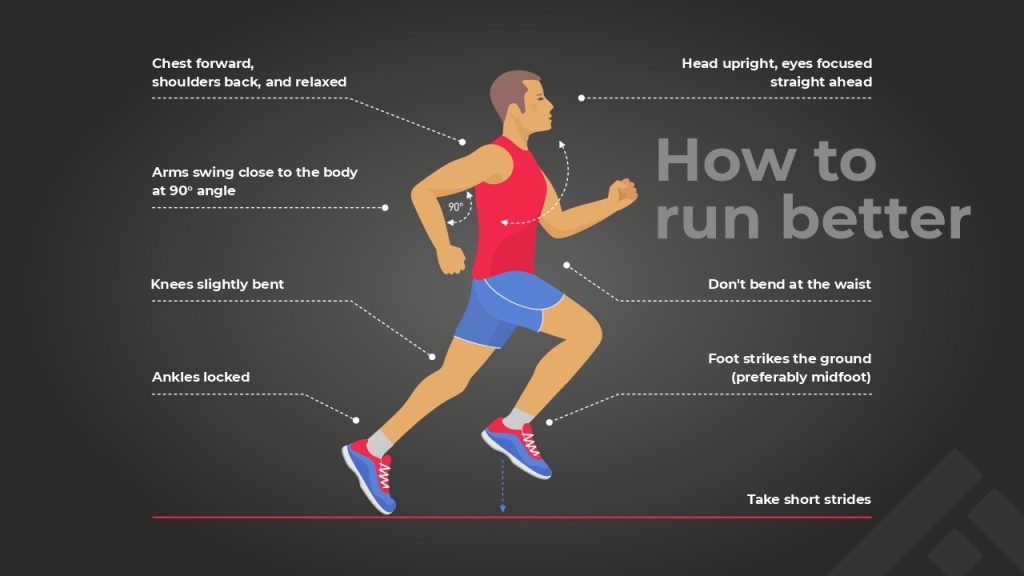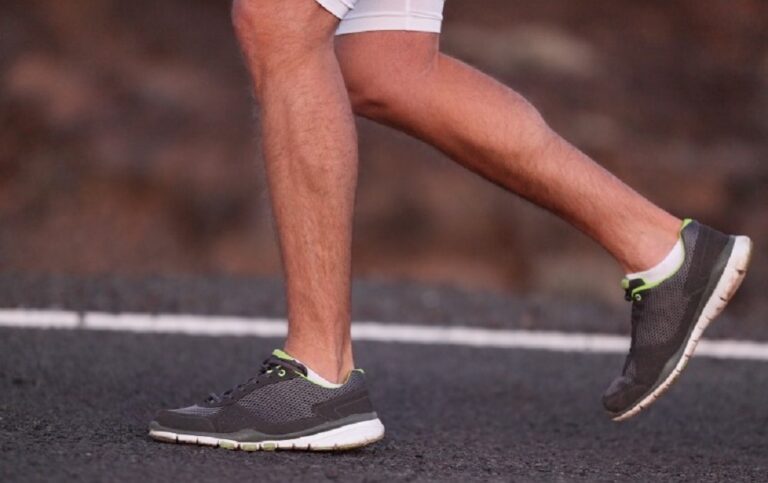Good Running Technique for Beginners (Ultimate Guide)
Good running technique for beginners requires proper posture, relaxed shoulders, short strides and a midfoot landing. If you’re new to running, it’s important to start with the proper technique to avoid injury and burnout.
Running is an excellent way to stay in shape and improve your overall health, but it can be a challenge for beginners. Proper running technique is essential to avoid injury and increase endurance. In this article, we’ll cover the basics of good running technique for beginners.
We’ll discuss the importance of posture, the proper stride length, and foot placement. With these tips, you’ll be well on your way to becoming a better, more efficient runner. So, let’s dive in!
Basic Running Form: Posture, Stride, And Foot Placement

Image Credit: fitpage
Good Running Technique For Beginners
If you’ve decided to start running, congratulations! Running is a great way to improve your physical health, stay in shape, and boost your mood. But, as a beginner, it’s essential to learn proper running technique to avoid injury and get the most out of your workout.
In this blog post, we’ll focus on basic running form- posture, stride, and foot placement.
Importance Of Proper Posture During Running
Maintaining proper posture while running is crucial because it can help you prevent injuries and run more efficiently. Here are the key points to keep in mind:
- Keep your head up with your eyes looking ahead, not down at the ground.
- Maintain a straight line from your head to your feet.
- Keep your shoulders relaxed and your shoulders blades pulled down and back.
- Engage your core muscles to maintain a stable and upright torso.
The Right Stride Length For Effective Running
Having the right stride length is essential to maintain your balance and avoid injury. Here are the key points to keep in mind:
- Take smaller steps rather than long ones. You should aim to take 160 to 180 steps per minute.
- Do not over-stride as it can lead to injuries. Landing heel-first can lead to knee pain and shin splints.
- Avoid landing on your toes as it can cause calf and achilles pain. Land on the middle of your foot to ensure a safe landing.
Foot Placement Strategies: Heel Vs Midfoot Vs Forefoot
Foot placement is significant in running as it can affect your performance and risk of injury. Here are the key points to keep in mind:
- Heel striking is not the best way to run as it creates too much impact on the body. Instead, aim to land midfoot or forefoot. You should aim to land lightly, rolling through your foot and pushing off your toes.
- Landing midfoot allows for a gentle, smooth landing and reduces the impact of each stride.
- Forefoot landing provides a spring-like effect, and the foot is more active in the running motion.
Proper running technique can help you achieve your running goals. Remember to maintain the right posture, take smaller steps, and land midfoot or forefoot to avoid injury and run efficiently. Keep practicing these techniques, and you’ll be on the path to becoming a more skilled runner!
Arm Movement: How To Use Your Arms For A Better Run
Running is a simple yet challenging exercise that requires proper technique to reap its benefits. In this beginner’s guide, we will focus on the role of the arms in running, specifically the ideal arm swinging motion and common mistakes to avoid while swinging arms.

The Role Of The Arms In Running
The arms play a crucial role in running as they act as a counterbalance to the legs, helping maintain stability and balance. A proper arm swinging motion can also affect the rhythm and efficiency of your running. Here are the key points:
- The arms should be relaxed at a 90-degree angle, with an open and loose fist.
- Shoulders should be relaxed, down, and away from the ears.
- The movements should be forward and backward and not crossing over the body’s midline.
- The arms should swing naturally, not too high or too low.
The Ideal Arm Swinging Motion
To obtain an ideal arm swinging motion while running, you need to focus on the proper technique. Here are the key points:
- The arms should swing forward naturally, but not cross the midline.
- Your elbows should be at a 90-degree angle, and your hands should be relaxed.
- The arms should swing forward to the hip level, and they should swing back to the same position, not beyond it.
- Your shoulders should be relaxed, and your upper body should be led by chest and not by the hands.
Common Mistakes To Avoid While Swinging Arms
As a beginner, you may make common mistakes while you’re running. These mistakes may make your running less efficient and more challenging. Here are some common mistakes to avoid while swinging arms:
- Swinging arms across the midline: It might cause a loss in balance and affect your efficiency.
- Clenching fists rather than keeping them relaxed: It can cause tension in the upper body and lead to unnecessary energy consumption.
- Swinging arms too high or too low: It can cause an imbalance in your running form and may affect your breathing.
- Too much tension in the shoulders: It can lead to aches and pain in the shoulders and neck.
An ideal arm swinging motion plays a crucial role in running. Follow the proper technique and avoid common mistakes to ensure stability, efficiency, and proper breathing while running.
Breathing Techniques: Optimizing Oxygen Intake
Running is an excellent way to boost your health and get in shape. However, beginners often struggle to achieve the right running technique, which can lead to injuries and inefficiency. One of the most important aspects of proper running form is breathing techniques.
We will discuss how beginners can optimize oxygen intake while running, so they can achieve a successful and enjoyable workout.
Correct Breathing Techniques During Running
Proper breathing technique is essential for running efficiently and avoiding fatigue. Here are some key points to keep in mind while you run:
- Use your nose and mouth: Breathe in and out through both your nose and mouth, to maximize oxygen intake and exhale carbon dioxide.
- Breathe rhythmically: Inhale with a 2:2 pattern (two steps in, two steps out) or a 3:3 pattern (three steps in, three steps out), depending on your pace. Try to exhale with the same rhythm as well.
- Stay upright: Keep your back straight and your shoulders relaxed, which will give your lungs proper space to expand.
How To Breathe In And Out While Running
Proper breathing technique starts with effective inhalation and exhalation. Follow these guidelines to optimize your air intake:
- Breathe deeply: Inhale deeply, allowing your lungs to fill with oxygen.
- Use your diaphragm: Use your diaphragm to breathe, as it can achieve a full lung expansion.
- Relax your breathing: Avoid holding your breath, as it can increase tension. Instead, let your breathing be natural and relaxed, but deep.
Importance Of Deep Breathing And Pacing
Deep breathing and proper pacing can contribute to a successful running workout. Here are some points to keep in mind:
- Deep breathing: Deep breathing helps to deliver oxygen-rich blood throughout your body. It reduces stress and helps runners avoid lactic acid buildup.
- Pacing: Pacing yourself ensures that you don’t deplete all your energy reserves in the early stages of your run. Instead, start slowly and then increase your pace as your body warms up. This way you can maintain a steady breathing pattern and increase endurance.
By using proper breathing techniques, you can optimize your oxygen intake, reduce fatigue, prevent injuries and have an efficient running workout. With the above guidelines, beginners can start developing a good running technique that will lead to enhanced performance and benefits.
Start With Warm-Up Exercises And Stretching Techniques

Essential Pre-Run Stretches And Warm-Up Exercises:
Before hitting the track, it is essential to start with some warm-up exercises and stretching techniques. Here are some essential stretches and exercises that the beginners should consider before starting running:
- Walking lunges: Walking lunges work wonders before running as they help in enhancing flexibility and stretch the hamstrings, calves, quads, and glutes, making for a perfect exercise for a beginner.
- High knees: High knees is the ideal warm-up exercise because it helps in warming up the core, heels, quads, and hip flexors, which are crucial for running.
- Jumping jacks: Jumping jacks are a great way to get the heart pumping and the muscles warm-up before a run.
- Leg swings: Leg swings are excellent warm-up exercise, which can enhance mobility and promote healthy stride mechanics.
How To Avoid Injuries Or Strains While Running:
Running can lead to various types of injuries, including strains, twisted ankles, or even worse if appropriate precautions are not taken. Here are some tips that can help beginners avoid running injuries:
- Proper warm-up: Proper warm-up exercises and stretching techniques can help in avoiding injuries while running. It would help if you started with light exercises to loosen up the muscles before running.
- Wear appropriate running shoes: Wearing appropriate running shoes is essential as it provides the perfect support to the feet and reduces the risk of injury.
- Increase the intensity gradually: Beginners should not start running at high intensity as it can cause injuries due to the sudden jerk. Increase the intensity gradually to avoid injuries.
- Listen to your body: It is crucial to listen to your body while running. If you feel any pain or discomfort, stop running immediately, and avoid running until the pain goes away.
The Role Of Dynamic Stretching In Enhancing Running Performance:
Dynamic stretching is an active stretching technique that involves movements that simulate running and helps in enhancing running performance. Here are some benefits of dynamic stretching:
- Increased flexibility and range of motion: Dynamic stretches help in increasing the flexibility and range of motion, which allows the body to move freely, reducing the risk of injury.
- Enhanced running performance: Dynamic stretching enhances running performance by improving blood flow to the muscles and increasing the heart rate.
- Reduced muscle soreness: Dynamic stretching before running can reduce muscle soreness, helping in faster recovery after the workout.
- Reduced risk of injury: By increasing flexibility, dynamic stretching reduces the risk of injury, which is common during running.
Warm-up exercises, stretching techniques, and dynamic stretching can enhance the beginners’ running performance by reducing the risk of injury. It is essential to pay attention to the body while running and to start the intensity gradually. Always wear appropriate running shoes to reduce the risk of injury.
Happy running!
Interval Training: Boost Your Stamina And Endurance
Running can be a great way to boost your physical and mental health. However, it’s essential to maintain proper running technique to prevent injury, especially if you’re new to running. We’ll discuss how interval training can help you improve your stamina and endurance as a beginner.
What Is Interval Training?
Interval training is a running technique that involves alternating intervals of high-intensity exercise with periods of low-intensity rest or recovery. The intervals can vary in length and intensity depending on your fitness level and goals. Interval training workout sessions can last from 20 to 60 minutes, and the goal is to help you run faster and farther while improving your cardiovascular fitness.
Benefits Of Interval Training For Beginners
Interval training is a beneficial technique for beginners who want to improve their running technique and increase their stamina and endurance. Here are some of the advantages of interval training:
- Helps you burn calories and lose weight faster than traditional running
- Helps build endurance, strength, and speed
- Reduces the risk of injury by helping you control your pace better
- Can be done on any surface or terrain
- Helps improve cardiovascular health by increasing your heart rate and circulation
How To Incorporate Interval Training Into Your Running Routine
If you’re a beginner, it’s best to start with a simple interval training routine and gradually increase your intensity and duration. Here are some tips to help you incorporate interval training into your running routine:
- Start with a warm-up: Always start your running session with a light warm-up to loosen your muscles and prevent injury.
- Choose your intervals: Depending on your fitness level and goals, select your interval durations and intensities. For beginners, start with short intervals, such as one minute of high-intensity running followed by two minutes of rest or low-intensity running.
- Gradually increase your intensity: Once you feel comfortable with your interval duration, increase the intensity gradually. The aim is to improve your running technique and endurance while avoiding injury.
- Keep track of your progress: To monitor your progress, keep a record of your interval durations, intensities and distances covered.
- Cool down: Finish your workout with a cool-down session, such as a slow jog or stretching, to prevent muscle soreness and stiffness.
Interval training is an excellent technique for beginners who want to improve their running technique and increase their stamina and endurance. Make sure to incorporate interval training into your running routine gradually and keep track of your progress to avoid injury and measure improvements in your fitness level.
With the right technique, you can enjoy the benefits of running and improve your physical and mental wellbeing.
Finding The Perfect Running Shoe: A Guide For Beginners

When it comes to running, your shoes are your most crucial piece of gear. They provide you with the support and cushioning you need to stay injury-free and to run further. For beginners, finding the correct running shoes can be challenging.
With many different brands, models, and technologies available, it’s easy to feel overwhelmed. But don’t worry – we’ve got you covered. This guide will help you determine which running shoes are best for you and how to choose the perfect fit.
Factors To Consider While Choosing Running Shoes
Before you buy a pair of running shoes, there are a few things you should consider. These include:
- Arch type: The arch of your foot will affect the type of support and cushioning you require. Determining your arch type can help you narrow down your options.
- Foot strike: How your foot hits the ground when you run can also impact the type of shoes you choose. Are you a heel striker, forefoot striker, or midfoot striker?
- Pronation: Pronation refers to the way your foot rolls inward when you land. Knowing your pronation can help you find shoes that provide the correct support.
- Surface: Consider the surface that you’ll be running on. Different surfaces require different types of shoes. For instance, road shoes are meant for pavement, while trail shoes are suitable for uneven terrain.
Understanding these factors can help you narrow down your options and find a shoe that works best for you.
Best Type Of Running Shoes For Beginners
If you’re a beginner, it’s best to choose a running shoe that’s versatile. Here are some of the best types of running shoes for beginners:
- Neutral shoes: These shoes are suitable for runners with a normal arch and foot strike. They provide balanced cushioning and support.
- Lightweight shoes: These shoes are beneficial for beginners who want to work on speed and agility.
- Trail shoes: If you plan on running off-road on dirt paths or rocky terrain, trail shoes are the right choice. They offer more stability and protection than road shoes.
How To Select The Perfect Running Shoe Fit
Getting the right fit is essential to ensure comfort and prevent injury. Here’s how you can select the perfect running shoe fit:
- Get measured: It’s best to get measured by a professional to ensure that you’re buying the correct size. Try on shoes in the afternoon or evening when your feet are swollen.
- Leave some space: Leave a space of around the width of your thumb between your longest toe and the end of the shoe.
- Wiggle your toes: Make sure you can wiggle your toes comfortably.
- Walk or run: Take the shoes for a walk or a short run to test their comfort and fit. Make sure they don’t rub or slide around.
By following these steps, you can make sure you get the correct fit for your running shoes.
Overall, the right pair of running shoes can make a significant difference in your running experience. Consider the factors mentioned above, find the best type of running shoe for you and make sure you select the perfect fit. With the right gear, you’ll be well on your way to becoming a seasoned runner.
Skipping Warm-Up Exercises And Stretching Techniques
Do you want to improve your running performance? Well, it all starts with a proper warm-up routine. Skipping warm-up exercises and stretching techniques can affect your running posture and decrease your speed. We’ll discuss the consequences of skipping these techniques, along with pre-run tips to ensure effective performance.
Consequences Of Skipping These Techniques
Sometimes, you may feel too eager to start running or feel that warm-up exercises are a waste of time. However, avoiding these techniques can lead to several consequences that can hinder your running performance. These include:
- Risk of injuries such as sprains and strains
- Poor running posture
- Reduced running speed
- Difficulty breathing properly during the run
- Difficulty recovering after the run
Pre-Run Tips For Effective Performance
Now that you know the possible consequences of skipping warm-up exercises and stretching techniques, the following pre-run tips can help you prepare for a successful run:
- Dynamic stretching techniques such as lunges, high-knees and leg swings, can help warm up your muscles before running and prevent injuries.
- Static stretching techniques such as quad and hamstring stretches, can be added after your dynamic stretches to further reduce the risk of injuries.
- Gradually increase the intensity and speed of your run to avoid heavy breathing during the run.
- Take breaks during your run to rest and catch your breath.
- Cool down after your run with some light jogging followed by static stretching exercises.
Remember that incorporating warm-up exercises and stretching techniques into your running routine is essential for preventing injuries, improving running posture, and enabling a long-lasting runner’s life.
Running Too Much, Too Soon
As a beginner runner, it’s tempting to push yourself too hard or too fast. However, running too much, too soon, can lead to serious injuries and setbacks. To prevent this from happening, understanding the risks of overtraining and gradually increasing running time is crucial.
In this section, we’ll discuss the potential risks of overtraining and ways to safely increase your running time.
Understanding The Risks Of Overtraining
Plain paragraph:
Overtraining occurs when you push yourself too hard, both physically and mentally, without allowing adequate rest and recovery time. Some potential risks of overtraining are:
Bullet points:
- Increased risk of injury
- Decreased endurance and performance
- Muscle fatigue and soreness
- Mood swings and irritability
- Reduced immune system function
How To Gradually Increase Running Time
Plain paragraph:
Gradual progression is key when it comes to running. Here are some ways to safely increase your running time without risking injury or burnout.
Bullet points:
- Start with a walk-run program: Begin by alternating between walking and running for set intervals, gradually increasing your running time and decreasing your walking time.
- Incorporate rest days: Rest days are crucial for recovery. Plan at least one rest day per week to allow your body to recover and rebuild.
- Gradually increase running time: Increase your running time by no more than 10% each week. For example, if you run for 20 minutes this week, aim to run for 22 minutes next week.
- Listen to your body: Pay attention to how your body feels during and after your runs. If you’re feeling particularly fatigued or sore, take a rest day or shorten your run.
- Strength train: Strengthening your muscles through weight training or bodyweight exercises can help prevent injury and improve running performance.
Remember, running should be a fun and enjoyable experience. Don’t let the temptation to push yourself too hard too soon lead to injury and setbacks. With gradual progression and proper rest and recovery, you can safely and effectively improve your running abilities.
Running With Inefficient Form

Common Technique Mistakes And How To Avoid Them
When you’re starting with running, you might find it challenging to maintain proper form and technique. This could lead to incorrect habits that can eventually cause injuries or impede progress. Here are some common mistakes beginners make, and how to avoid them:
- Leaning forward too much: This can increase the stress on your knees, cause straining on your back muscles and make you feel fatigued too soon. Try to keep your back straight, and lean neither too far forward nor backward.
- Overstriding: Overstriding means taking too large a step, which can lead to heel strike and consequently put stress on legs and joints and slows down your pace. Focus on taking shorter steps and landing on the middle of your foot for a more stable foundation.
- Twisting your torso: Rotating the upper body can cause unnecessary tension in the shoulders, making breathing more difficult and leading to backache. Instead, keep your hips straight, relax shoulders, and let your arms swing naturally at your side.
Tips To Improve Running Technique And Correct Bad Running Habits
Whether you’re a beginner or have been running for a while, practicing proper technique can help you reach your goals faster and prevent injuries. Here are some tips to enhance your running technique, correct mistakes and bad habits:
- Start slow: Begin with walking, then move up to running slowly. Gradually increase the intensity and duration of your runs over time.
- Focus on your posture: Keep your back straight, shoulders relaxed and avoid looking down at your feet or hunching over.
- Land gently: Avoid striking the ground too hard or crashing down on your heels. A light and gentle landing will lead to better form and reduce the impact on your joints.
- Be mindful of your stride: Try to take short, quick steps and land on the middle of your foot to make the most of your energy and avoid jarring impacts.
- Engage your core: Strengthening your core can help with stability and better posture, so don’t forget to incorporate core exercises into your workout routine.
By following these tips, you can improve your technique, avoid bad habits, and keep yourself safe from injuries while enjoying the benefits of running. Remember, it’s not all about speed or distance; form and consistency are critical in making progress.
Wearing The Wrong Shoes
Good Running Technique For Beginners
Running is a great way to stay fit and healthy, but it’s important to remember that there are certain techniques that need to be followed in order to avoid injuries. One of the most crucial aspects of running technique for beginners is wearing the right shoes.
How To Choose The Right Shoes To Avoid Injuries
Here are some key factors to consider when selecting the appropriate running shoes for you:
- Arch shape: Determine your foot’s arch shape as this can have an impact on the type of shoe that is best suited for you. Flat feet tend to require more support than high arches, which require more cushioning.
- Heel support: Look for shoes that have good heel support. A shoe with a heel that is too high or too low can lead to injuries.
- Flexibility: A good running shoe should be flexible enough to allow your foot to move naturally, while still providing enough support to prevent injuries.
- Fit: Always try your shoes on before purchasing them. Make sure that they fit well and don’t slide around on your feet.
Understanding The Importance Of Running Shoe Construction
The construction of a running shoe is also an important consideration when choosing the right pair of shoes for you. Here are some essential factors to consider:
- Sole design: Look for shoes with a sole that has good grip and support, as this will help prevent slips and falls.
- Breathability: Choose shoes that allow your feet to breathe, as this will reduce the likelihood of developing blisters and other foot-related injuries.
- Materials: Running shoes should be made from high-quality materials that are durable and can withstand wear and tear.
By considering these factors, you can help ensure that you choose the right running shoes for your needs, which will ultimately help you avoid injuries and keep you running for years to come. Remember to always prioritize quality over price and never compromise on comfort when it comes to running shoes.
Pushing Yourself Too Hard
Good Running Technique For Beginners: Pushing Yourself Too Hard
As a beginner, it’s essential to develop proper running techniques to avoid injuries and achieve your running goals. One of the biggest mistakes beginners make is pushing themselves too hard. It’s tempting to push yourself harder and go further, but it’s important to recognize the signs of overexertion while running.
Here, we’ll discuss the signs of overexertion and some recovery and rest techniques for better performance.
Signs Of Overexertion While Running
- Shortness of breath
- Increased heart rate
- Muscle fatigue or pain
- Feeling light-headed or dizzy
- Chest pain or discomfort
- Cramping or stiffness
- Nausea or vomiting
If you experience any of these signs, it’s time to slow down your pace or even stop and take a break. Overexertion can lead to injuries which can ruin your running routine.
Recovery And Rest Techniques For Better Performance
Recovery and rest are essential parts of any training routine. Here are some techniques to help you recover effectively:
- Stretching: After a run, stretching your muscles can ease tension and pain, improving your flexibility.
- Massage: Massage therapy after running can help reduce muscle tension, accelerate the healing process, and improve circulation.
- Rest days: Rest days are essential for recovery. It’s important to take at least one rest day per week to recover from your previous running sessions.
- Hydrate: Staying hydrated before, during, and after running is essential for performance and recovery.
- Sleep: Getting enough sleep is essential for recovery and better performance. Aim for at least 7-8 hours of sleep per night.
Pushing yourself too hard can lead to injuries that can set you back on your running routine. Recognizing the signs of overexertion while running and implementing proper recovery and rest techniques will help you achieve your running goals. Keep practicing these techniques to develop proper running techniques and pave the way for improvement.
Hydration And Nutrition Ignorance
Good Running Technique For Beginners
Whether you are an athlete or someone who wants to lead a healthy lifestyle, running is a great exercise. But, running is not just about putting one foot in front of the other; it’s also about proper technique, hydration, and nutrition.
In this blog post, we’ll be diving into the importance of hydration and nutrition, and how it can make or break your running performance even if you’re a beginner.
Understanding The Importance Of Hydrating Before And After Running
Hydrating before and after running is key to performance and smooth recovery. Here are some key points to keep in mind:
- Hydrating before running can prevent dehydration and fatigue during your workout, especially if you’re running in hot or humid weather. Drink at least 16-20 ounces of water 2-3 hours before running and an additional 8-10 ounces of water 10-15 minutes before hitting the pavement.
- Hydrating after running helps to replenish fluids lost during your run and promote effective recovery. Drink 16-24 ounces of water 30 minutes after completing your run and continue to hydrate throughout the day.
- You can opt for sports drinks that replenish electrolytes that are lost through sweating, but avoid consuming drinks loaded with sugar.
The Role Of Proper Nutrition In Running Performance
Nutrition plays a critical role in your running performance. Proper nutrition can result in faster recovery, higher energy levels, and consistent progress. Here’s what you need to know:
- Consume carbohydrates for energy – carbs are converted into glucose, which is the primary source of energy for your body during running. Focus on eating unprocessed carbs such as whole grain bread and pasta, fruits such as bananas, and vegetables such as sweet potatoes.
- Protein is key for muscle recovery – protein provides your body with the necessary materials to repair and grow your muscles. Aim to consume 1.2-1.7 grams of protein per kg of body weight.
- Don’t skimp out on healthy fats – healthy fats keep you full and provide your body with essential nutrients. Aim to consume heart-healthy fats such as those found in fish, nuts, and avocado.
- Stay hydrated throughout the day to prevent feeling sluggish and fatigued.
By adhering to proper hydration and nutrition practices, you can take your running to the next level while keeping yourself feeling good and healthy. Incorporate these tips into your routine from day one, and it will quickly become second nature.
Happy running!
Lack Of Planning
Importance Of Preparing A Running Plan
One of the common pitfalls beginner runners often fall into is starting without a plan. Going for a run without a well-thought-out plan can often lead to injuries, setbacks, and frustration. Hence, it is crucial to prepare a running plan before starting to run.
Here are some key points to keep in mind while preparing a running plan:
- Set realistic goals: With a running plan, it is essential to set realistic goals that align with your fitness level and abilities. For instance, if you are a beginner, starting with a 5k or 10k may not be the ideal goal. Start small and gradually increase the distance to avoid injuries.
- Schedule the days: Once you have set your running goals, decide on the days you will be running. It is recommended to spread out your running days throughout the week to give your muscles time to rest and recover.
- Map your running route: Map out your running route beforehand to avoid getting lost or confused while running. You can use online tools like mapmyrun or strava to map your route and make adjustments if necessary.
- Track your progress: Tracking your progress can help you stay motivated and see the progress you are making. You can use mobile apps like nike+ run club or runkeeper to track your runs and monitor your performance.
Setting Realistic Goals For Beginners
Setting realistic goals is a crucial aspect of preparing a running plan. As a beginner, it is common to get carried away and set ambitious goals that may lead to injuries and burnout. Here are some tips to set realistic goals as a beginner runner:
- Start small: It is essential to start small and gradually increase the distance and intensity of your runs. Starting with shorter distances like 1-2 miles can help your body adjust to the demands of running, reducing the risk of injury.
- Assess your fitness level: It is crucial to assess your fitness level before setting running goals. Factors like age, weight, and prior exercise experience can affect your ability to run. Hence, it is best to consult with a healthcare professional or a running coach to determine a realistic running goal.
- Focus on consistency: Consistency is the key to success in running. Instead of setting lofty goals, focus on being consistent with your runs and gradually increasing the distance and intensity over time.
- Celebrate small wins: Celebrate small wins along the way to keep yourself motivated and on track. Completing a 5k or running for 20 minutes non-stop can be a great achievement for a beginner runner.
Remember, running is a journey, not a destination. By setting realistic goals and preparing a running plan, you can make the most out of your running experience, improve your fitness level, and avoid setbacks and injuries.
Running Alone Vs Running With A Group
Good Running Technique For Beginners
Running is an enjoyable and healthy activity for people of all ages. However, as a beginner, you might feel confused about running alone or with a group of runners. Both scenarios have their advantages and disadvantages that can impact your training and running performance.
In this section, we will explore the pros and cons of running alone and running with a group.
Pros And Cons Of Running Alone
Running alone is a convenient option for beginners who are not familiar with running in groups. Here are the pros and cons of running alone:
Pros:
- You can run on your own schedule and at your comfortable pace.
- You can choose the route and distance based on your fitness level and personal preferences.
- Running alone allows you to focus on your running form and technique without any distractions.
- You can listen to your favorite music or podcast while running alone.
Cons:
- Running alone can be lonely and boring, especially when you train for long-distance running.
- Safety can be a concern, especially when you run in the dark or unfamiliar areas.
- Without any guidance or support, you might not be able to improve your running performance or avoid injuries.
- It might be challenging to motivate yourself and keep yourself accountable for your running routine.
Finding Running Groups And Buddies For Better Performance
Running with a group can provide you with a social support system that can boost your motivation and performance. Here are the key points of finding running groups and buddies:
Pros:
- Running with a group can help you stay motivated and committed to your running routine.
- You can learn from experienced runners and coaches who can provide you with feedback and guidance.
- By running with a group, you can create new friendships and enjoy the social aspect of running.
- Group running can be safer and more pleasant than running alone, especially in crowded or urban areas.
Cons:
- Running with a group might not fit your schedule or pace, which can lead to frustration or social anxiety.
- You might feel pressured to keep up with the group’s performance, even if it means sacrificing your form or technique.
- Group running can be distracting if you are not used to running with others, leading to potential injuries or mistakes.
- You might have to pay a membership fee or commit to a regular schedule that might be inconvenient for you.
Whether you decide to run alone or join a running group, make sure to consider your personal preferences, safety concerns, and fitness goals. It is essential to enjoy your running routine and stay consistent to achieve long-term health benefits.
Inadequate Warm-Down Techniques
Importance Of Cooling Down After Running
Cooling down is as important as warm-up exercises. Finishing a run is not a cue to sit or lie down on the ground, but a cue to slow down your pace with a short, easy jog or walk. Cooling down is an integral part of preventing injuries, preparing the body for the next run, and regulating blood flow.
Here are the reasons you should never skip the cool-down process:
- Helps in reducing post-run soreness: Cool-down exercises help in circulating blood through your sore muscles, reducing stiffness, and helping to decrease muscle soreness after your run.
- Minimizes the risk of injury: Cooling down allows your heart rate to decrease gradually, which reduces the stress on your heart. Sudden cessation of running can result in fainting spells or other medical conditions.
- Reduces lactate levels: Lactic acid builds up in muscles during intense exercise. A cool-down helps prevent a sudden drop in blood pressure and can help remove extra lactic acid from your muscles, which can result in cramping or muscle soreness.
Best Warm-Down Exercises For Beginners
Doing the right warm-down exercises can help your body to transition smoothly back to a resting state. Here are the most effective warm-down exercises for beginners:
- Walking: Walking is the simplest and most effective warm-down exercise. It can help lower your heart rate, gradually reducing the intensity of your workout.
- Stretching: Stretching exercises can be done after walking. Gentle stretching of your calf muscles, hamstrings, quadriceps and hip flexors for about 10-15 seconds, repeated 2-3 times, can help reduce muscle soreness.
- Foam rolling: Use a foam roller to release the tension in your muscles after running. Foam rolling can help to increase blood flow to your muscles and reduce stiffness and soreness. Spend 2-3 minutes on each area of the body.
- Yoga poses: Doing simple yoga poses like downward dog or child’s pose can help stretch your muscles and calm your mind.
Remember to make cooling down a habit after every run. Doing so will help prepare your body for the next workout and protect you from injury.
Frequently Asked Questions
What Is The Correct Posture For Running?
To maintain correct posture while running, keep your head up, look straight ahead, align your shoulders over your hips, and activate your core muscles. Avoid slouching or tilting your head to prevent injuries and improve your performance.
How Do I Know If My Running Shoes Fit Properly?
Your running shoes should fit snugly with enough room for your toes to wiggle. You must also ensure that there is adequate space between your toes and the shoe’s tip. Purchase your shoes in the afternoon when your feet are at their widest to ensure an accurate fit.
How Do I Avoid Over-Striding When Running?
Over-striding is when you land your foot too far in front of your body, causing your heel to strike the ground first. You can avoid over-striding by landing on your midfoot or forefoot and keeping your feet under your hips.
Reducing your stride length and increasing your cadence will also help.
Should I Breathe Through My Mouth Or Nose When Running?
You should breathe through both your nose and mouth when running. Inhaling and exhaling through your nose warms and filters the air, while breathing through your mouth increases oxygen intake. Depending on the intensity of your workout, use your mouth to breathe more deeply.
Why Is A Consistent Pace Important In Running?
Maintaining a consistent pace improves your cardiovascular endurance and helps you achieve your running goals. It also helps you conserve energy and prevent injuries. Experiment with different paces and find one that allows you to run comfortably while covering the distance you desire.
Conclusion
As a beginner, having good running technique is essential to avoid injury and improve performance. It’s important to focus on maintaining proper posture, keeping a consistent stride, and landing midfoot. Incorporating strength and mobility exercises can also help you develop a better running form.
Remember to gradually increase your mileage and listen to your body to prevent overuse injuries. Don’t compare yourself to others or try to run at a pace that is too fast for you. Consistency and patience are key to developing a good running technique.







